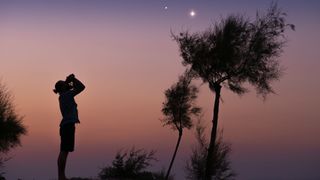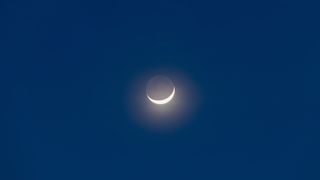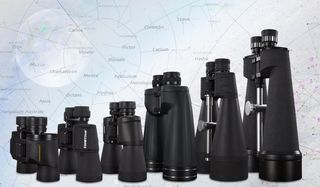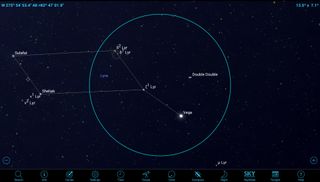Stargazing with Binoculars: Beginner Tips
Get a new perspective on the jewels of the night sky by stargazing with binoculars.

Are you ready to go deeper into the night sky? If you’re figuring out the constellations and now want to probe the star clusters, nebulae and planets hidden within them there’s no better investment than a decent pair of binoculars. Capable of giving you a close-up of deep sky objects that are invisible to your naked eyes and often impossible to appreciate through even the best telescopes, stargazing with binoculars can be inexpensive but always expansive, instantly unlocking a new layer to your view of the vast beyond.
Here are some top tips for getting the most out of the best binoculars for stargazing and astronomy — and seeing hundreds of thousands of stars, star clusters and galaxies.
Why use binoculars over a telescope?
If you think a telescope is better for astronomy than stargazing with binoculars then you’re misunderstanding the nature of the night sky. It’s in 3D, it’s got depth and objects of vastly different sizes. So, while a telescope’s magnification is useful for looking at deep-sky objects with a small apparent size close-up, their restricted field of view means they’re not as good for studying closer objects or those with a larger apparent size.
There are three other reasons why stargazing with binoculars trumps a telescope: they’re much more affordable, ridiculously easy to use and show a right-side-up image, unlike many telescopes which show everything upside-down.
What to point your binoculars at
Objects that look uniquely beautiful when stargazing with binoculars include the Orion Nebula (M42), the Andromeda Galaxy (M31), the Pleiades (M45) and Hyades open cluster in the constellation Taurus, the double stars Mizar and Alcor in the Big Dipper and, of course, the Moon. You can also point your binoculars at Jupiter to see not only the gas giant in all its glory, but its four giant Galilean moons (Ganymede, Europa, Callisto and Io).
A great way to approach binocular stargazing is to use them to help you discover what’s in that ‘second layer’ of the night sky as you learn to navigate the cosmos by tracing out the constellations of the bright stars. Sweep your binoculars across constellations close to the Milky Way, such as Cassiopeia and Perseus in winter and through the Summer Triangle asterism in summer, and you’ll be astounded by what you can see.

When to look at the Moon using binoculars
The first thing beginners look at through their new binoculars is almost always the Moon. They’re perfect for following the Moon’s phases as it orbits Earth each month. A couple of evenings after the new moon you’ll be able to see a crescent moon in the western sky just after sunset. The slim curve of light looks incredible through binoculars, but look to the darkened limb, too, and you’ll see ‘earthshine’ — reflected light from the Earth shining back on to the Moon.
As the month wears on, point your binoculars at the terminators — the line between light and dark on the Moon — and you’ll see shadows that reveal vast craters (Copernicus, Tycho and Plato, to name a few), mountain ranges such as the Montes Apenninus and lunar seas such as the Sea of Tranquility, Sea of Showers and Ocean of Storms. The Moon looks flat when it’s full, and almost too bright to look at through binoculars, so catch it at moonrise around dusk and you’ll get a wonderful view of our natural satellite in space.
How to choose a pair of binoculars for stargazing
The best binoculars for stargazing balance magnification with letting as much light in as possible. For beginner stargazers the ideal combination is a low magnification of around 7x to 10x and an aperture of about 42mm to 50mm. Binoculars with these specifications — expressed as 7x42, 10x50 or similar combinations — are small and light enough to hold reasonably steady. They also give a wide enough field of view of the night sky and create a bright image in darkness. (Our favorite pair of binoculars are the Celestron TrailSeeker 8x42.)
If you wear glasses it’s also worth thinking about the distance that your eyes are from the eyepiece. This eye relief can make all the difference to comfort when stargazing with binoculars, and if you wear glasses you’ll benefit from a longer eye relief.
Other technical features to look out for are Porro prisms, multi-coated optics and barium crown (BAK4) glass. All will feature in stargazing-centric binoculars. Our in-depth article on how to choose binoculars for astronomy and skywatching goes into even more detail.

How to focus your binoculars
There’s slightly more to stargazing with binoculars than using that focusing knob on the top. Many binoculars also have a diopter ring around the right eyepiece that helps you compensate for differences between your own two eyes. To calibrate your binoculars for your eyes, in daylight put a lens cap over the right barrel and use the central focusing knob to create a sharp image for your left eye for something in the middle distance. Then put a lens cap on the left barrel and use the diopter ring to focus for your right eye.
How to hold your binoculars steady
Does everything look wiggly? That’s because you’re human and you move constantly, even when you think you’re being still. If you’re looking straight ahead of you at something close to the horizon then you’re also battling gravity. So, when stargazing with binoculars, hold the binoculars towards the end of the tubes, not close to the eyepiece, keep your elbows in against your chest and either lean against a wall or sit in a chair. It’s also worth remembering that if you look directly up (which is also the darkest part of the sky) and let the binoculars rest on your face, you’ll no longer be fighting gravity so should get a more stable image.
How to find objects with your binoculars
Get yourself a star chart, and maybe an awesome mobile astronomy app for your phone, and decide what you’re going to look at. Even if it’s something bright, like Jupiter or the Moon, it’s likely that you’ll have a little trouble aiming the first time you’re stargazing with binoculars. The best way to aim is to find the location of the object you want to see with your naked eyes and then put the binoculars in front of your eyes. If you need to scan the area, do so in a circular movement.

How to use averted vision to see more
Point your binoculars at something with diffuse light — such as the Andromeda Galaxy (M31) or the Great Cluster in the constellation Hercules (M13) — and initially you might not get the full impact. That’s because you’re looking straight at them. Your peripheral vision is the most sensitive to brightness, so look slightly to the side of a faint fuzzy object and your eyes will see a lot more light. This averted vision technique is as close to a long exposure photograph as the human eye can get!
When not to use binoculars
There’s a tendency for those new to stargazing to hear the words "meteor shower" and think "fetch the telescope and binoculars"! While binoculars are excellent for stargazing, they’re not ideal for all-sky celestial events. That includes meteor showers, for which you need as wide-eyed a view of the night sky as possible. The same goes for the aurora borealis — the northern lights — which always look best when viewed with the naked eye.
You should also avoid using binoculars for any kind of planet-spotting or stargazing close to the Sun if it’s in the sky. That includes solar eclipses, though it is safe to use binoculars to look at the Sun’s corona during the brief moments of totality. In fact, there’s not a more beautiful sight in nature than the Sun’s corona through binoculars!
Used wisely, a simple pair of binoculars can bring a lifetime of joy from stargazing without you ever having to go near a cumbersome, complicated telescope.
Join our Space Forums to keep talking space on the latest missions, night sky and more! And if you have a news tip, correction or comment, let us know at: community@space.com.
Get the Space.com Newsletter
Breaking space news, the latest updates on rocket launches, skywatching events and more!

Jamie is an experienced science, technology and travel journalist and stargazer who writes about exploring the night sky, solar and lunar eclipses, moon-gazing, astro-travel, astronomy and space exploration. He is the editor of WhenIsTheNextEclipse.com and author of A Stargazing Program For Beginners, and is a senior contributor at Forbes. His special skill is turning tech-babble into plain English.
